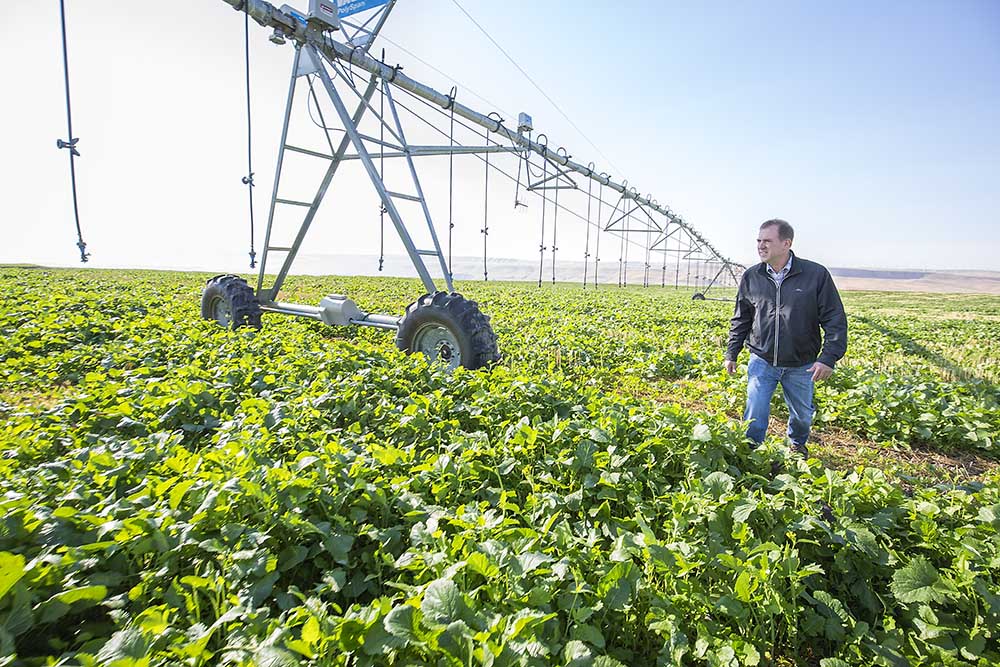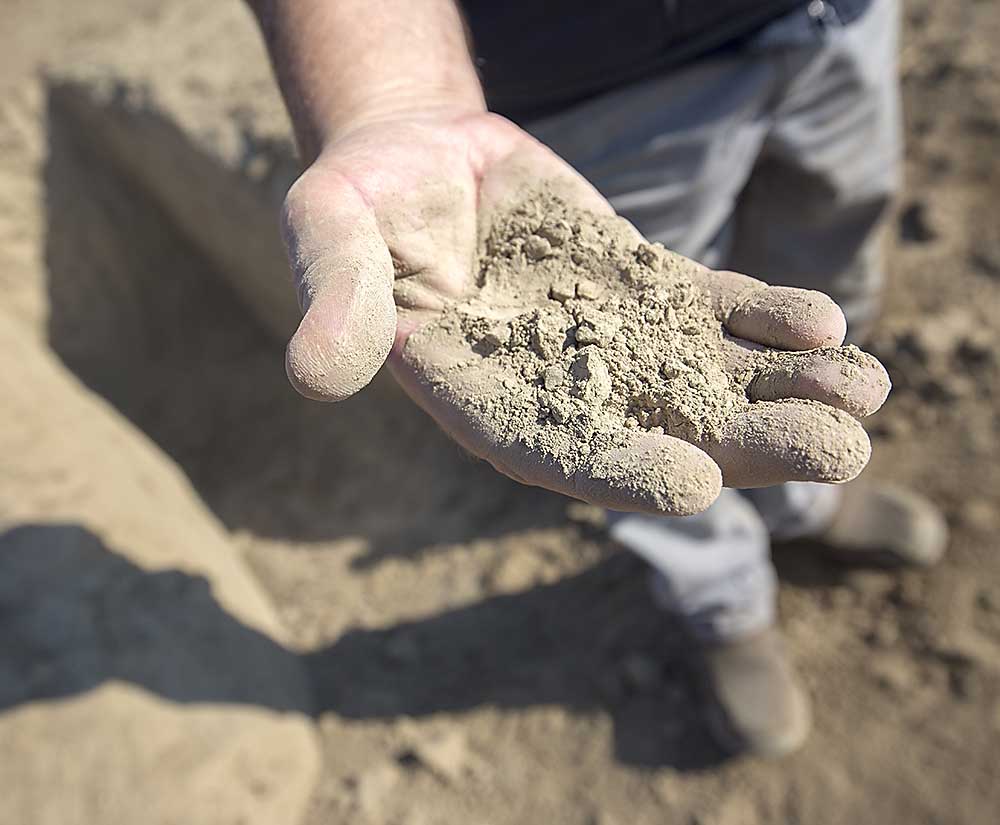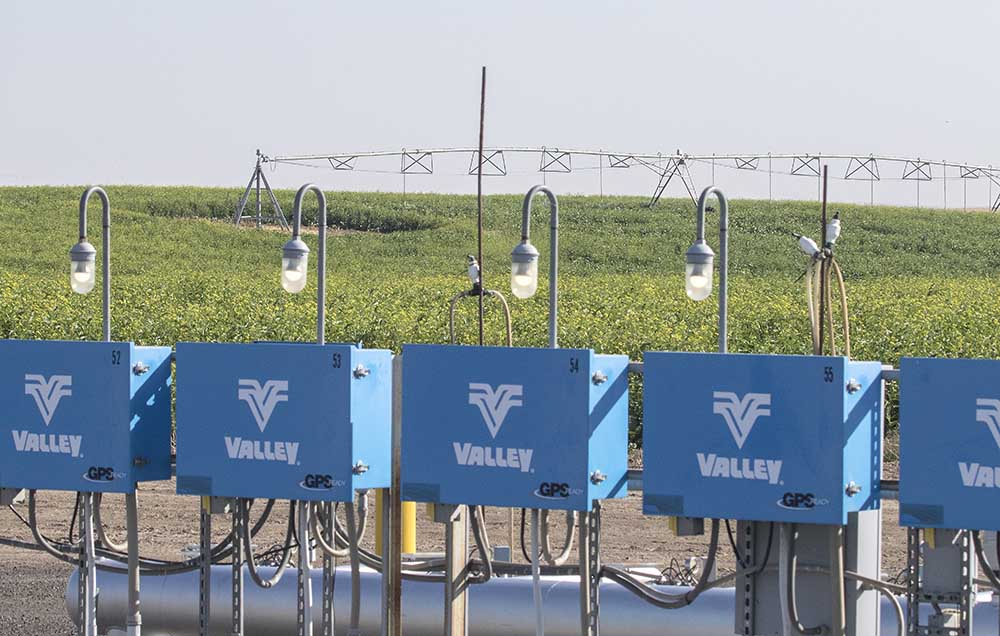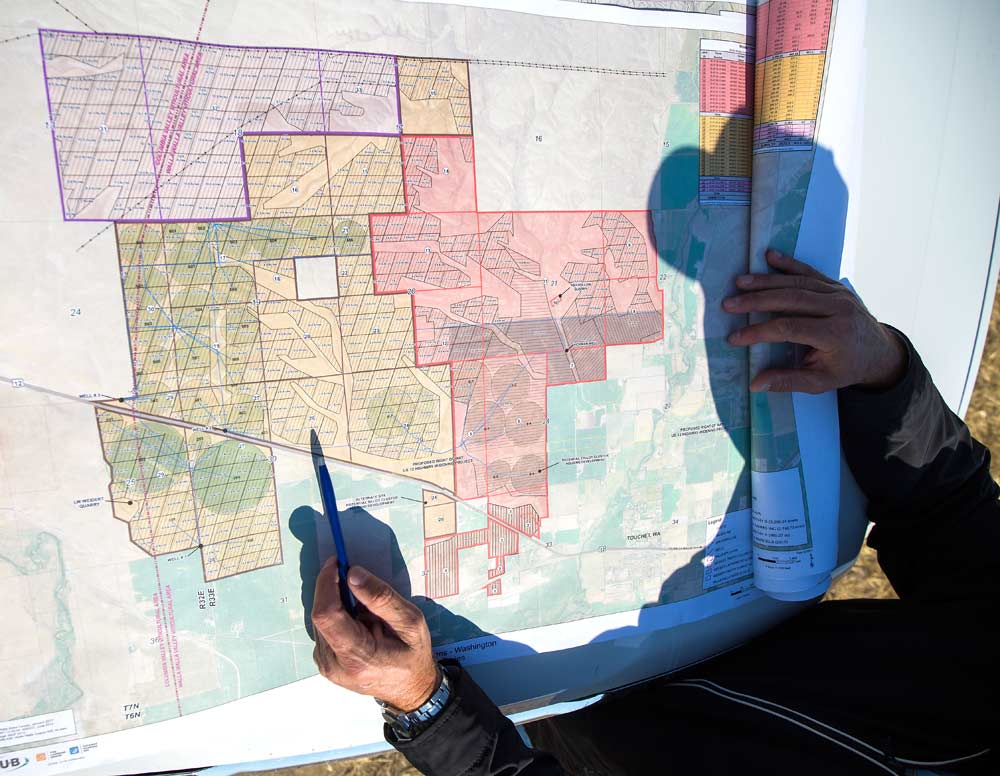
Tim Weidert walks through one of many Weidert Farm crop circles that have been converted from wheat to mustard, near Touchet, Washington in September, 2017. Weidert planted mustard two years ago and has been tilling it into the soil to serve the next owner as a natural fumigant. (TJ Mullinax/Good Fruit Grower)
It’s a heck of a view for a vineyard. Nobody has planted one yet, but that could soon be about to change.
Six thousand acres – much of it prime ground for vineyards or orchards – and irrigation water rights in Washington’s Walla Walla Valley are up for sale in a sealed bid auction. Now home to dryland wheat and irrigated row crops, the expanse known as Weidert Farm represents an exciting and, no-doubt, expensive opportunity for someone looking to develop more permanent crops in the Columbia Basin.
“The fact that the property falls largely in the Walla Walla Valley AVA and the cache that carries, and it’s rolling upland landscape, and to top it off, the large amount of deeded water, really makes it desirable,” said Alan Busacca, a soil scientist and vineyard development consultant working with the seller. “There are definitely quite a few parties that are quite interested in this property, yet everyone acknowledges the size and scale and time frame required to really do this property justice.”
Bidding closes on Nov. 10. So far, interested parties in the site include tree fruit, wine grape and hop growers, along with institutional investors, such as the managers of a retirement fund, who would seek local partners to farm it, said Steve Bruere, the broker managing the sale.
Such large land auctions are rare in desirable growing regions in the Pacific Northwest, but not unprecedented. In 2012, a partnership associated with Gebbers Farms of Brewster, Washington, bought a 16,000-acre ranch on south-central Washington’s Rattlesnake Mountain for $7.6 million. Plans for development of the sagebrush-covered cattle ranch have not been made public.
In 2013, 670 undeveloped acres in the nearby Red Mountain AVA were purchased for $8.3 million by a Canadian company. The Aquilini Investment Group surprised local wineries interested in the land by bidding on all 31 parcels, which they are now planting largely in Cabernet Sauvignon, along with Merlot and Cabernet Franc, according to Great Northwest Wine.
The Weidert property was not broken into parcels for ease of sale for irrigation reasons. Developing permanent crops on the site will require spreading the water currently used to pivot irrigate in the southwestern corner of the property to the higher slopes better suited for vineyards or orchards.
“Given the way that the water rights are set up, the water needs to be spread to those higher elevation acres and to do that on the front end, not knowing if it’s going to be sold to wine grapes or tree fruit, made it too complicated,” said Bruere, president of the People’s Company, an Iowa-based real estate broker. “The folks that are going to develop it and grow crops on it need to make those decisions.”
A farm tale

Stu Turner shows what he calls a typical example of the soil makeup at Weidert Farm near Touchet, Washington in September 2017. Turner, an agronomist, says there’s very few rocks on the property, and in this particular 6-foot dig in the background, didn’t have a stone to be found. (TJ Mullinax/Good Fruit Grower)
The seller, Tim Weidert, is a Pendleton, Oregon-based dryland wheat farmer, whose family has been acquiring and improving the land since his father bought the first parcel in the 1960s.
Weidert said he’s loved developing the property to this point, improving the soils with organic matter and installing irrigation, but he’s ready to pass it along to someone with expertise in permanent crops to truly take advantage of the landscape’s agricultural and scenic benefits. “In the spring, when everything is starting to green up in the valley and the blue mountains are capped with snow, it is just one of the most beautiful views you can see,” he said.
When Tim took over the property from his father, just as the wine grape industry began to take off in the Walla Walla region in the 1980s, he began applying for state water rights and drilling wells. “I just knew water was going to be key to this farm,” he said.
That bet should pay off, as new water rights in the region are now limited. Four deep wells provide just over 5,000 acre-feet of water and permits allow for another well to draw 900 acre-feet more. There’s also an allocation for 167 acres from the Touchet River, which translates to over 700 acre-feet.

One of several new irrigation management stations that are installed on the over 6,000 acres for sale by Weidert Farms. (TJ Mullinax/Good Fruit Grower)
The buyer will likely want to move much of that water from the currently irrigated 1,600 acres on pivots to the higher elevation slopes that offer good cold air drainage, Busacca said. There are lots of options for crop placement, because the soils on the site are deep and very uniform, he added.
Generally, the Walla Walla Valley AVA ranges in elevation from 400 to 2,000 feet above sea level. This property’s elevation ranges from 440 feet in the southeast, where Weidert thinks residential development would be a good fit, to over 900 feet along the ridges.
“There are very few places in the state where you would find this large a piece of land with such consistently fine soils,” Busacca said. “It’s not difficult to get to 3,000 eminently farmable acres for a mix of crops.”
Neighboring winery owner Rick Small said he welcomed more investment in the Walla Walla Valley AVA and is eager to watch how the property develops. His Woodward Canyon Winery is east of the Weidert property, and he said that based on his own experience, only the highest elevations on the property may be suited for wine grapes.
“I’m up at about 800, 900 feet and for some of my lower stuff I still have to have wind machines,” Small said, adding that he expects a mix of wine grapes and tree fruit would make the most of the Weidert property’s rolling hills. “For someone who wanted to grow premium wine grapes in the Walla Walla Valley appellation, it’s a great opportunity.”
The Walla Walla Valley AVA covers about 500 square miles in Oregon and Washington and is home to 3,000 acres of highly regarded wine grapes and more than 60 wineries.
Since Weidert is asking for noncontingent bids, he hired experts to offer potential buyers as much information about the property as possible up front, Bruere said, including soil maps, geology, farming history, and an environmental review. But there is always some uncertainty with a new development, especially at this scale.

Tim Weidert shows the map of Weidert Farm near Touchet, Washington, highlighting potential growing zones and the current wind drainage of the property on September 29, 2017. This site is part of over 6,000 acres for sale by Weidert. (TJ Mullinax/Good Fruit Grower)
“Everybody who is interested in developing this property wants climate data about what zones would be suitable for tree fruit or wine grapes,” Busacca said, but there were no weather stations on the property until this summer. Still, he expects the 1,900 acres that fall above 800 feet would minimize winter chill for wine grapes because it’s the backbone of ridge with excellent air drainage. “We’re quite confident that the acreage above 800 are comparable to the best acreage rimming the Walla Walla Valley and on the hills above Milton Freewater.”
Of course, tree fruit growers are also looking for good soils and sites that minimize the risk of winter injury, so there is likely to be competition for the property.
Whoever ends up developing it, Busacca has a tip: Put in a winery at the viewpoint that looks out across the Walla Walla Valley and promote it as the first stop on any visit to the appellation. “It would be a wonderful thing if someone wants to put a destination winery there on those higher parts of the ground because the views are absolutely breathtaking.”
– by Kate Prengaman






Leave A Comment